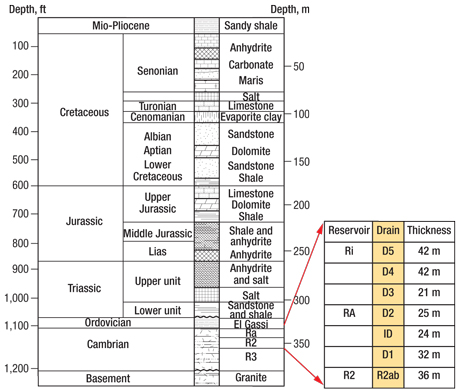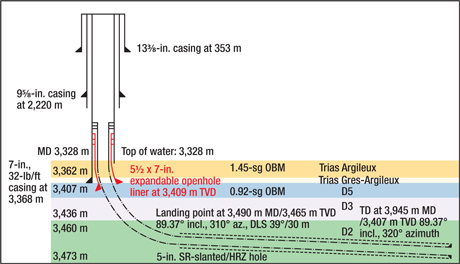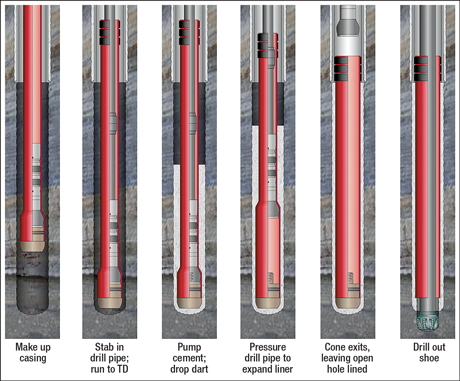Expanding an openhole liner to isolate a high-pressure shale zone preserved hole size and prevented a slimhole configuration in the production zone.
Marc Saad and Pat York, Weatherford International Ltd.; and Ali Ferhat, Sonatrach
Hassi Messaoud Field, about 1,200 km south of Algiers, provides an example of how technology has enabled workover operations to revitalize mature assets. This oil field in the Triafic Basin and the surrounding region contain about 60% of Algeria’s proved crude oil reserves. The field was discovered in 1956, and produced about 400,000 bpd of crude oil in 2008, primarily from a thick sandstone reservoir that covers an area of 2,000 sq km. This Cambrian reservoir is subdivided into four zones (Fig. 1)—from top to bottom, Ri (D5), Ra, R2, R3.2 The R3 producing layer, which occurs at an average depth of 3,400 m, is characterized by variable petrophysical properties. The properties impacting productivity, including porosity, shaliness and permeability, remain unpredictable despite 50 years of knowledge accumulated from drilling more than 1,400 wells.
 |
|
Fig. 1. Summarized stratigraphy for Hassi Messaoud Field with a detailed column of the four productive zones in the Cambrian reservoir.1
|
|
Conventional drilling practices in this field place the 7-in. casing inside an 8⅜-in. hole drilled about 3 m into the Ra zone. The well is then drilled to the R3 production zone and completed with one of various configurations, including slotted liners, cemented liners and openhole barefoot-type completions. After years of production or because of well damage, these types of wells can be plugged back, sidetracked and drilled to the R3 zone. A typical workover program consists of extending the open hole in the reservoir zone below the 7-in. casing and producing through a new 4½-in. perforated liner. This approach requires the use of an additional, smaller casing string, eventually drilling the reservoir openhole section with a much smaller hole size and completing the well with a slimhole configuration. Downsizing casing and the completion decreases economic viability and increases mechanical complication risk.
RECOGNIZING OPPORTUNITY
Several oil production wells drilled over 40 years ago in Hassi Messaoud Field have been shut in and are awaiting workover plans to restore them to economic production. The past few years have seen great strides in the development of technology and processes to deliver on those needs, one of the most valuable being solid expandable tubulars. This technology had not been used in Algeria until Sonatrach incorporated it into the Hassi Messaoud Field workover project.
The first prime candidate for expandable technology was found with a well originally put on production in December 1978. The producing zone was drilled nearly vertically, and 7-in., 32-lb/ft casing was set about 19 m above the production zone. At the time of completion, this exposed 19-m shale zone had the same pore pressure as the producing reservoir, which extended from 3,368 m to 3,430 m MD. After several decades of production, the reservoir pressure was so depleted that the shale zone started caving inward, forcing the well to be suspended. Several other wells slated for workover in the campaign showed the same decline in reservoir pressure, which was found to be as low as one-third of the shale formation pressure.
For the initial well, Sonatrach’s workover plan targeted production from a horizontal hole in the Ra-D2 zone. The variation in formation pressures between exposed shale and reservoir zones created a need to mechanically isolate this exposed shale zone immediately above the lower-pressure reservoir before drilling ahead. The original workover plan involved running the usual extra casing string, which would require the reservoir openhole section to be drilled with a much smaller hole size and completed with a slimhole configuration. Rather than compromise hole size, Sonatrach incorporated Weatherford’s 5½ x 7-in. HydraSkin openhole liner (Fig. 2) to isolate the high-pressure shale zone above the reservoir and enable drilling of a short radius and horizontal section with a lower-density drilling fluid. This short radius and horizontal producing hole could be drilled with a 5-in. hole size to avoid a slimhole configuration and allow for a future intervention.
 |
|
Fig. 2. Well design schematic.
|
|
OPERATION
The well was re-entered and the kill string was removed. The existing wellbore was plugged back and a shallow, angle-type whipstock was installed to sidetrack the well through the 7-in., 32-lb/ft casing. The whipstock design allowed for adequate dogleg severity not only to install the solid expandable casing but also to accommodate the additional assemblies required to drill and complete the well in the 5-in. open hole. After installing the whipstock and initiating the sidetrack operation, the well was drilled with a 5⅞-in. bit to the casing point 3 m inside the Cambrian formation. A concentric-type under-reamer was run to enlarge the wellbore to 7 in., wide enough for a suitable annulus to cement the solid expandable liner and provide effective zonal isolation. The well was then drifted. Mechanical hole-cleaning tools integrated into the drift string ensured that no metal debris remained that could complicate the sealing of the casing. The expandable liner was made up, run through the window exit and under-reamed openhole to the setting depth. The window through which the solid expandable liner was set was located 40 m above the 7-in. casing shoe. This placement enabled a 11.5° inclination to be built at the kickoff point for the short radius below.
After cementing the liner in the hole, the pressure was increased to 3,000 psi and the first single joint was expanded. The drill pipe was connected to the top drive; then, using the rig, pump pressure steadily rose to 3,000 psi, where it stabilized. The weight indicator then began to drop off, indicating the start of expansion. Expansion continued systematically using the rig’s mud pump as the next three stands of 3½-in. drill pipe were pulled from the hole and stood back in the derrick. On the 11th joint, the cone expanded the first of the elastomer bands.
The openhole system incorporated an expandable liner hanger with hydrogenated nitrile butadiene rubber (HNBR) elastomers that energized when compressed against the 7-in. casing inner wall, creating a 4,000-psi pressure seal. HNBR elastomers display resistance to common wellbore fluids and retain their physical strength and properties even after long-term exposure to heat, oil and chemicals. As the cone passed the elastomers, the pressure in the standpipe stabilized at 3,000 psi. After pulling an additional 6-m, 90-kip overpull, the cone exited the top of the solid expandable liner with minimal jar at the surface. The well was circulated, and the expansion assembly was pulled from the hole in excellent condition with minimal wear to the expansion cone.
The solid expandable liner was subsequently pressure tested to 500 psi, and the float shoe was milled, Fig. 3. The well was then drilled and completed to target depth, successfully attaining the 5-in. openhole short radius followed by the planned horizontal openhole section. The completion included a 4½-in. blank liner across the solid expandable and a 4-in. pre-perforated liner in the open hole. The solid expandable liner held back the shale zone—which had an equivalent pore pressure of about 1.45 specific gravity (sg)—and allowed the reservoir to be drilled with a mud weight equivalent to 0.88 sg.
 |
|
Fig. 3. Solid expandable openhole liner installation sequence.
|
|
LEVERAGING SUCCESS
The favorable results, including the short cycle for the return on investment, obtained with the first application led Sonatrach to recognize subsequent opportunities. A gas appraisal well originally drilled in January 2009 in Nezla Field presented the familiar challenge of variant pressures. While drilling the 8½-in. hole section, the well was placed in suspension when an unexpected high-pressure formation was encountered.
After re-entering the well and drilling about 90 m, an under-reamer was used to enlarge this 8½-in. hole to 9⅞ in. The open hole was cased off with a 7⅝ x 9⅝-in. HydraSkin solid expandable openhole liner, which covered the bottom part of the openhole section below the 9⅝-in. casing without tapering the hole. Sonatrach was able to then drill ahead using a 7½ x 8½-in. bi-center bit without being exposed to high-pressure zones in the next 8½-in. section.
The expandable liner used is a hydraulic bottom-up expansion system that uses the expandable casing with a sealed shoe as a pressure chamber to pump the swaging mandrel (the cone) from the bottom of the expandable liner to its top. Its design maximizes running clearance to minimize the effect on equivalent circulating density and run time and helps avoid differential sticking. The system can be configured to run in either cased-hole or openhole applications.
The most recent application of solid expandables in Algeria was again in Hassi Messaoud Field and emulated the first installation. A 5½ x 7-in. Weatherford MetalSkin openhole liner set through a window extended the 7-in., 32-lb/ft casing and isolated the high-pressure shale zone. This system enabled Sonatrach to continue the drilling program as planned with a 5-in. openhole section extended horizontally in the reservoir. Unlike the first solid expandable application, this system uses a collapsible cone that can be closed, enabling the cone to be retrieved in case a contingency is needed.
FURTHER DEVELOPMENTS
The reliability and flexibility of the solid expandable liners in workover operations increase production capacity as compared to slimhole configurations. Medium to large-scale workover campaigns in particular can see added value from the use of solid expandable liners to maximize production, extend reach and enhance the life of wells.
Solid expandable systems with enhanced developments are being installed in wells that present unconventional problems. Metal-to-metal expandable connections provide an innovative way to develop gas fields that require at least 7-in. production casing. Expandable systems can extend top-hole sections of casing and still result in equivalent wellbore ID, in case high- or low-pressure reservoirs are encountered and casing needs to be set above the anticipated target depth.
Further innovations being implemented use swellable elastomers to provide better zonal isolation when depleted formations will not support a full hydrostatic column. Additional enhancements provide long-term solutions to poor zonal isolation, conventional cement deterioration and breakthrough of corrosive well fluids into the production casing. 
LITERATURE CITED
1 Balducchi, A. and G. Pommier, “Cambrian oil field of Hassi Messaoud, Algeria,” in Halbouty, M. T., ed., Geology of Giant Petroleum Fields, AAPG Memoir No. 14, 1970, pp. 477–488.
2 Farhat, A. et al., “Open-hole solid expandables eliminate slim-hole configuration in integrated solution workover well,” SPE 127792-PP presented at the SPE North Africa Technical Conference and Exhibition, Cairo, Egypt, Feb. 14–17, 2010.
|
THE AUTHORS
|
 |
Marc Antoine Saad is the Regional Product Line Manager for Weatherford’s Solid Expandable Systems in the Middle East and North Africa. He has been involved in solid expandables for the past three years. Before joining Weatherford, he spent six years working in applications management for new and developing oilfield technologies. Mr. Saad holds a master’s degree in engineering from McGill University in Montreal, Quebec, Canada.
|
| |
Pat York is the Director of Commercialization for the Weatherford’s Solid Expandable Systems. He has been involved with expandable technology for 11 years and has 36 years’ experience in the industry. Mr. York received a bachelor’s degree in electrical engineering at Northwestern State University in Natchitoches, Louisiana, and pursued his MBA degree there.
|
| |
Ali Ferhat is Sonatrach’s Operation Director for Hassi Messoud Field, having previously worked at the field as Operations Supervisor for production. Mr. Ferhat has more than 27 years of experience in the oil industry in a variety of sectors including workover operations, production operations and drilling.
|
|






